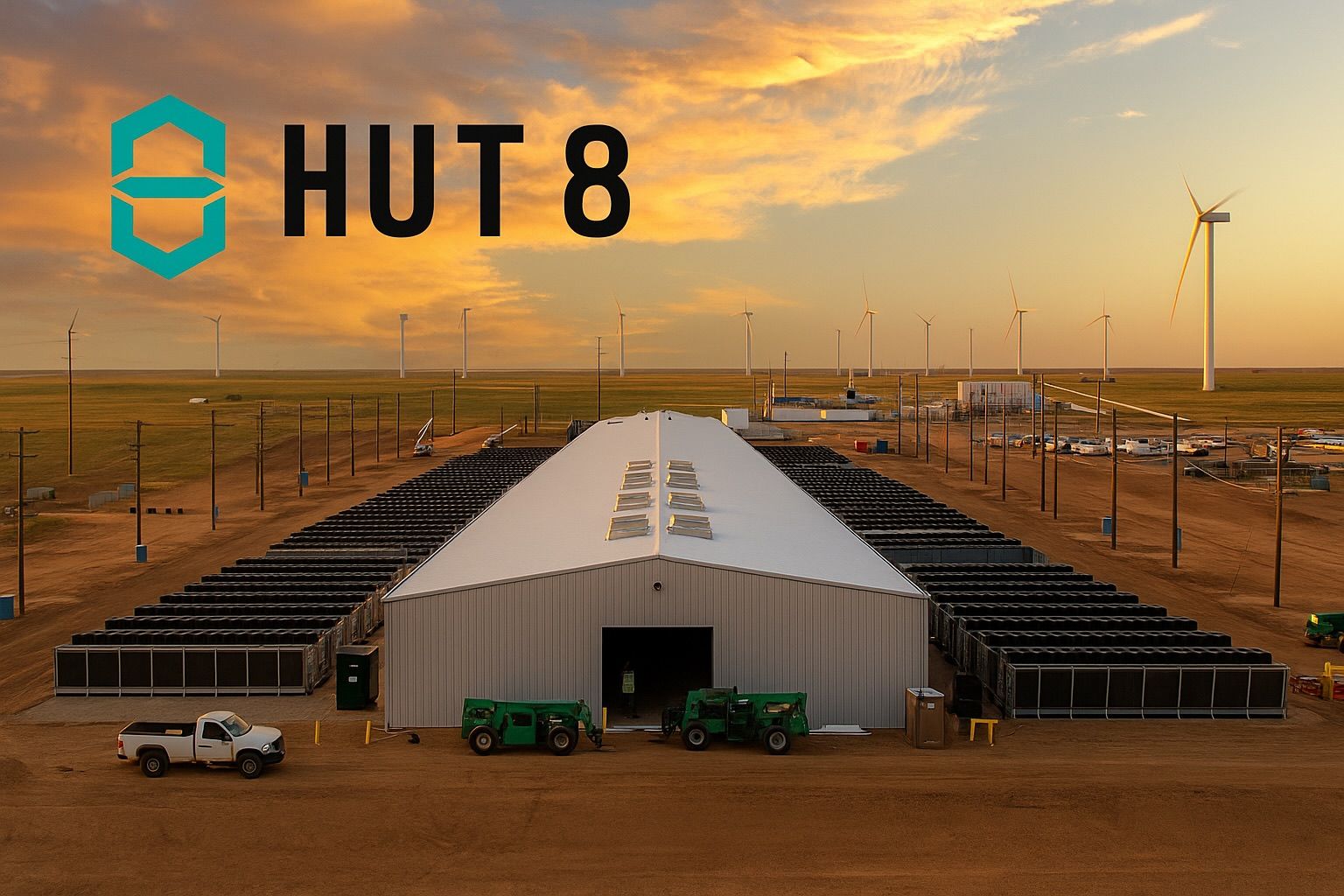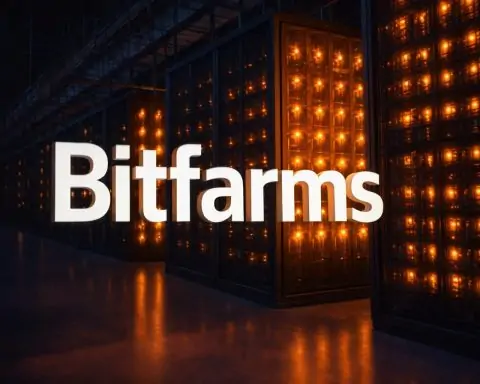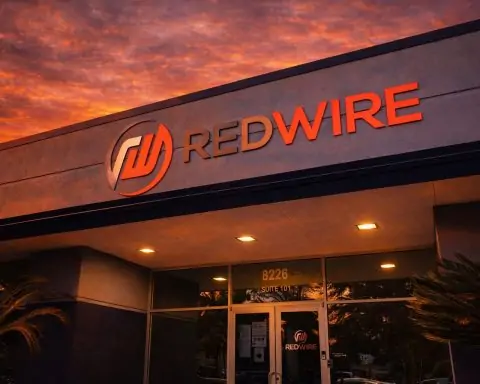- Crypto Surge & Volatility: Hut 8 Corp. (NASDAQ: HUT) stock nearly doubled in 2025 amid Bitcoin’s bull run, hitting multi-year highs this month [1]. Toronto-listed shares jumped ~15% on Oct. 14 to ~C$70 (US ~$49) [2]. However, crypto mining stocks tumbled 10–15% on Oct. 22 as markets turned risk-off [3], with HUT falling back toward the mid-$40s after a parabolic rise.
- Current Price (Oct 22, 2025): HUT trades around $43–$45 on Nasdaq (C$54 on TSX) after an 8% intraday drop [4] [5]. It closed Oct. 21 near $49, then gapped down as part of a sector-wide slide despite Bitcoin holding ~$108K [6]. The stock’s 52-week range is $14 to $49 (CAD: $14 to $80) [7], reflecting its explosive growth over the past year.
- Trump-Backed Spinoff: In September, Hut 8 launched “American Bitcoin Corp.” (ABTC) via an all-stock merger backed by Eric Trump and Donald Trump Jr. [8]. Hut 8 retains ~80% ownership of ABTC, which debuted on Nasdaq and “vowed to become the world’s largest, most efficient pure-play bitcoin miner,” according to Reuters [9]. The Trump brothers hold about 20% of ABTC (worth ~$1.5 B at debut) [10] [11], giving Hut 8 a high-profile U.S. growth vehicle. Hut 8 itself has pivoted toward power infrastructure and hosting – leasing its data centers and 1.0+ gigawatt capacity to ABTC and other clients [12] [13] – marking a strategic shift beyond traditional self-mining.
- Crypto Tailwinds: Bitcoin’s price neared $120,000 in early October, its highest in years [14], fueled by optimism over a potential U.S. Bitcoin ETF and pro-crypto policies under President Trump [15] [16]. Hut 8’s sizable Bitcoin treasury (~10,667 BTC) swelled to over $1.1 B in value [17], and miners like Hut 8, Marathon and Riot saw outsized gains (15–18% single-day pops in late September) [18] [19]. Analysts note “when BTC soars, miners often see amplified gains,” given their high leverage to crypto prices [20]. That said, record-high mining difficulty and next year’s Bitcoin halving are squeezing profit margins [21] [22] – a reminder that industry challenges persist even in a boom.
- Analyst & Expert Outlook: Wall Street remains bullish on Hut 8 despite its rapid run-up. 19 of 20 analysts rate HUT a “Buy” or better [23], and firms like Piper Sandler and Roth Capital have issued aggressive price targets of $74 and $60 (USD) [24]. BTIG also doubled its target to $55 (Buy) after Hut’s expansion moves [25]. However, the average 12-month price target (~$38) remains below the current price [26] [27], indicating some valuation concern. CNBC’s Jim Cramer cautioned that HUT’s recent “parabolic” rally looks “very suspect,” advising investors to “ring the register on some” profits [28]. Technical indicators are mixed – HUT trades far above its 50-day average (~$34) [29], but momentum has cooled and daily technical signals are now neutral [30], reflecting the stock’s consolidation after its meteoric rise.
- Key Catalysts Ahead: Hut 8 will report Q3 2025 earnings on Nov. 4 [31], offering a fresh look at its post-merger financials. Investors will watch for updates on the 1.53 GW development pipeline (backed by partners like Coinbase) [32] and the ramp-up of hosting revenues from ABTC and AI clients. The company’s “power-first” strategy has secured long-term energy contracts (e.g. 310 MW over 5 years in Ontario) [33], aiming to deliver stable cash flow. With peer miners like Marathon and Riot valued around $7B each [34] [35], Hut 8’s ~$5B market cap is now “in the same league” [36] – a testament to its growth, but also setting a high bar. Broader market factors – crypto regulatory shifts, energy prices, and Bitcoin’s trajectory – will heavily influence whether HUT’s wild ride continues into 2026.
Bitcoin Boom Propels Hut 8 to Record Highs (Then a Pullback)
Hut 8 stock has been on a roller coaster in October 2025, mirroring the volatility of the crypto market. In the first half of the month, HUT rode a wave of euphoria as Bitcoin’s price rocketed to levels not seen in years. Bitcoin briefly topped $115,000–$120,000 in early October [37] [38], driven by optimism around a possible U.S. Bitcoin ETF approval and a crypto-friendly regulatory climate. This Bitcoin boom translated into amplified gains for mining stocks – high-beta plays that tend to outperform the underlying asset’s moves. Hut 8’s shares soared nearly 18% in late September alone amid the rally [39], vastly outperforming the broader equity market. By October 14, the stock hit a fresh 52-week high around C$70 on the Toronto Stock Exchange (about $49 USD) [40] [41], after a single-day jump of ~15%. That put HUT up ~95% year-to-date in 2025 [42] [43] – a stunning run that far outpaced major indices.
Fueling this surge were both external and internal tailwinds. Externally, the prospect of the first U.S. spot Bitcoin ETF and supportive signals from Washington (under President Donald Trump’s administration) boosted sentiment [44] [45]. Internally, investors cheered Hut 8’s strategic moves (discussed below) to diversify its business model beyond pure Bitcoin mining. “When BTC soars, miners often see amplified gains,” notes tech investor site TS2, especially as renewed crypto optimism lifted the entire sector in late Q3 [46]. At the same time, Hut 8’s massive Bitcoin treasury – over 10,000 BTC held on its balance sheet – ballooned in value to more than $1.1 billion as crypto prices climbed [47]. This treasury acts as a double-edged sword: it boosts net asset value in bull markets, but also adds volatility to earnings (through mark-to-market gains or losses).
After peaking in mid-October, however, Hut 8’s stock saw a bout of profit-taking and broader market turbulence. By October 22, crypto-related stocks pulled back sharply as investors turned cautious on high-flying “momentum” names. Bitcoin miners with AI and data-center pivots – Hut 8, Bitfarms, Cipher, HIVE – plunged 10–15% on Oct. 22 during morning trading [48]. The CoinDesk Bitcoin Mining Index (ticker: WGMI) dropped ~7% that day [49], reflecting a wider risk-off move on Wall Street (the Nasdaq was down ~1% [50]). Hut 8 fell from ~$49 to the low-$40s amid this pullback [51]. According to MarketBeat data, HUT traded as low as $44.30 on Oct. 22 before stabilizing around $43.31 by mid-day [52] – roughly a 7–8% one-day drop. The previous day’s close was $46.92, so the stock gave back some of its recent gains but remains well above its early-year levels [53]. Analysts attributed the dip to a mix of factors: some traders locking in profits after a “parabolic” multi-month run [54], and broader market jitters around high-valuation tech plays (even Bitcoin itself eased off recent highs to ~$108K [55] [56]). Notably, even after the pullback, Hut 8’s stock is hovering near levels that would have been all-time highs just a year ago – underscoring how far it has climbed in 2025.
Trump-Linked Spinoff Reshapes Hut 8’s Strategy
One of the most significant developments for Hut 8 this year is its bold corporate restructuring to separate and turbocharge its Bitcoin mining operations. In September, Hut 8 launched a new U.S.-based subsidiary, American Bitcoin Corp. (NASDAQ: ABTC), through an all-stock merger that brought in prominent backers. This venture is no ordinary spinoff – it’s co-founded and heavily funded by members of the Trump family, which has drawn considerable public attention. Eric Trump and Donald Trump Jr. own roughly 20% of American Bitcoin Corp. (through shares and options) [57], while Hut 8 retains the majority stake (~80%) as the largest shareholder [58] [59]. The deal, which involved merging Hut 8’s assets with Gryphon Digital Mining into the new entity, allowed ABTC to debut on Nasdaq in early September without a traditional IPO [60].
American Bitcoin Corp.’s mandate is straightforward: scale up mining aggressively. The new company “has vowed to become ‘the world’s largest, most efficient pure-play bitcoin miner,’” according to Hut 8 CEO Asher Genoot’s comments to Reuters [61]. ABTC plans to accumulate bitcoin both by mining and by opportunistic purchases, depending on market conditions [62]. By listing ABTC separately, Hut 8 effectively unlocked fresh capital and star power for its mining arm – the listing brought in anchor investors like the Winklevoss twins and even saw ABTC’s stock more than double intraday in its debut (before settling up 16% at $8.04) [63] [64]. At one point on launch day, the market valued ABTC at over $10 billion (though it closed around $7.3 B) [65] [66], illustrating the appetite for crypto plays tied to famous names. “Crypto is exploding… it’s at least 50% of what I’m doing,” Eric Trump said during the debut [67], as he and his brother celebrated what instantly became a billion-plus stake for the Trump family.
For Hut 8, the creation of ABTC represents a strategic pivot. Essentially, Hut 8 carved out its primary self-mining operations into the new venture, allowing ABTC to focus on bitcoin production while Hut 8 shifts toward a “picks-and-shovels” model – providing the infrastructure and energy to power mining and other high-performance computing. As CEO Asher Genoot explained, Miami-based Hut 8 is now an “energy infrastructure and data center” firm first and foremost [68], leveraging its expertise in running large-scale power-intensive facilities. Hut 8 has built or acquired data centers across North America and manages about 1,020 megawatts of power capacity (90% under long-term contract) with another ~1,530 MW in development across new U.S. sites [69]. Many of these sites are in energy-rich regions (Texas, Alberta, etc.) and increasingly utilize renewable sources like wind and solar, aligning with industry trends. Under the new structure, Hut 8 will lease its facilities and electricity to American Bitcoin Corp. for mining, effectively becoming ABTC’s host and service provider [70] [71]. This arrangement gives Hut 8 steady, contracted revenue (through hosting fees and power sales), while ABTC shoulders the day-to-day volatility of mining output. It’s a symbiotic relationship: if ABTC thrives, Hut 8 benefits via its equity stake and its role as “landlord” to the mining operations.
Beyond mining, Hut 8’s infrastructure can serve other clients, especially in the booming field of artificial intelligence and cloud computing. The company has been touting a prototype “liquid-cooled” data center unit (Project Vega) designed for AI workloads [72]. Management calls Vega a “clear expression” of Hut 8’s “power-first, innovation-driven approach” to next-gen computing infrastructure [73]. The goal is to attract AI and high-performance computing (HPC) customers alongside crypto miners, essentially running a dual revenue stream. This mirrors a broader shift among crypto miners in 2025: major players like Iris Energy, Marathon Digital and CleanSpark are repurposing parts of their facilities for AI cloud services or selling excess power to the grid [74]. At a recent SALT industry conference, mining CEOs (including Hut 8’s team) discussed “monetizing megawatts” through hosting and HPC as key to surviving the next Bitcoin halving [75]. Hut 8’s spinoff and pivot put it at the forefront of this trend – positioning the company as not just a miner, but an energy and data infrastructure conglomerate for the crypto/AI era.
Current Stock Performance and Market Context
As of October 22, 2025, HUT stock is trading around $43–$45 per share on the Nasdaq, after a volatile week. That price reflects a slight cooldown from its recent peak near $49, but still represents a dramatic increase from where it started the year (sub-$25). On the Toronto Stock Exchange, where it also trades under ticker HUT, the stock is around C$54 today [76]. Volume has fluctuated with the stock’s volatility – on Oct. 22, midday trading volume was down sharply (only ~1.2 M shares by midday, versus a 5.9 M daily average) as the price fell [77], suggesting some buyers stepped to the sidelines.
It’s worth noting how far HUT has outrun traditional benchmarks. Even after the pullback, Hut 8’s shares are up approximately 100% year-to-date [78], vastly outperforming the S&P 500 (roughly flat in 2025) and even Bitcoin itself (which is up around 80% YTD). The 52-week trading range for HUT spans from about $14 on the low end to ~$49 at the high [79] – highlighting the stock’s high-beta nature. For context, HUT spent much of 2024 trading in the teens, before mounting a steady climb in the first half of 2025 and then going nearly vertical in Q3 as crypto markets caught fire. Over the last 50 trading days, HUT’s average price was only ~$34 [80], illustrating how quickly it sprinted above that level in the recent rally. Some technical analysts caution that such a steep ascent can lead to oversold conditions once momentum fades, and indeed we’re seeing a bit of that mean reversion now.
Broader market trends have also shaped HUT’s recent performance. The crypto sector’s pullback on Oct. 22 coincided with a general risk-off turn in equities – rising bond yields and a rotation out of speculative tech names hit everything from AI stocks to crypto miners. CoinDesk reported that Galaxy Digital (GLXY) – a fellow crypto firm pivoting to AI data centers – fell 15% on the same day, giving up its prior earnings-driven gains [81] [82]. Smaller mining stocks like Bitfarms (BITF) and Cipher Mining (CIFR) slumped 10%+ as well [83]. Bitcoin itself, while still around $108K, is off slightly from the $114K peak on Tuesday [84] [85], reminding traders that even in a bull market, corrections happen. These cross-currents have introduced more day-to-day volatility in HUT than earlier in the quarter, when the trajectory was mostly upward. Still, the overarching context for Hut 8 remains positive: the crypto market is in a much stronger place than a year ago (Bitcoin is roughly +250% vs. Oct 2024), and Hut 8’s fundamentals have improved through its merger and expansion (more on that below).
In the near term, traders are watching technical support levels – around $42 on the downside (roughly where the stock found footing on Oct. 22) and the high-$40s as resistance. The Relative Strength Index (RSI) on HUT recently cooled from “overbought” territory, and moving average convergence suggests the rally’s pace has moderated (MarketBeat’s automated signal shifted to “Neutral” this week) [86]. If Bitcoin resumes its climb toward a new all-time high (the previous ATH was ~$69K back in 2021, already surpassed this cycle), it could quickly reignite interest in miners like Hut 8. Conversely, any deeper pullback in crypto or a macro shock could drag HUT down further given its high correlation with Bitcoin.
Analyst Sentiment: Big Targets and Bullish Ratings
Despite the recent dip, analyst sentiment on Hut 8 remains overwhelmingly positive – albeit with an asterisk regarding valuation. According to MarketBeat data, the stock carries a consensus “Buy” rating with 19 out of 20 analysts covering HUT rating it a Buy/Outperform (and just 1 Hold) [87] [88]. The sheer number of bullish ratings underscores how quickly Hut 8’s execution and the crypto turnaround have won over Wall Street in 2025. Many analysts, in fact, have been scrambling to raise their price targets on HUT as the stock raced higher in recent months. For example:
- BTIG Research upgraded HUT on Oct. 14, boosting its price target from $33 to $55 (Buy) [89] [90], citing Hut 8’s enhanced growth outlook after the ABTC deal and infrastructure expansion.
- Piper Sandler initiated coverage with an Overweight and a street-high $74 target in mid-October [91], signaling confidence that Hut 8 can monetize its energy assets and perhaps benefit from the Trump-associated hype.
- Roth Capital likewise upped its target from $31 to $60 (Buy) in September [92], as the crypto rally gained steam and Hut 8 announced a 1.53 GW development pipeline backed by partners [93].
- Canaccord Genuity raised its target from C$32 to C$36 (Buy) back in late August [94], after Q2 earnings showed improved margins. (Canaccord’s target, roughly $27 USD, is now conservative post-rally.)
- On the cautious end, Northland Securities set a $26 target (Hold) over the summer [95], which is now well below the current trading price and reflects a pre-rally outlook that the stock has long since surpassed.
Overall, the average 12-month price target for HUT is about $36–$38 per share [96] [97], depending on the source – a figure notably below the present market price. In mid-October the consensus was ~$31 [98], but analysts have been revising numbers upward. The disparity between the stock’s trading price (low-$40s) and the consensus target (~$38) suggests that either HUT’s rally got a bit ahead of fundamentals, or analysts are expecting a breather after the huge run-up. Valuation debates have indeed started to percolate: Hut 8’s trailing P/E ratio is not very meaningful (inflated by one-time accounting gains on its Bitcoin holdings [99]), and on a price-to-sales basis HUT looks pricier than peers. Bears note that excluding those one-time revaluation gains, Hut 8 was not profitable on a GAAP basis in recent quarters [100]. However, bulls argue traditional earnings multiples aren’t the best way to view a company with such large crypto assets and growth projects – instead they point to Hut 8’s $221 M adjusted EBITDA in Q2 and strong balance sheet as more relevant metrics [101].
Several experts and commentators have weighed in on HUT’s remarkable rally. One high-profile voice, CNBC’s Jim Cramer, offered a word of caution this week. On his Oct. 21 “Lightning Round” segment, a caller asked if Hut 8 is a long-term hold given it’s “making money” now. Cramer acknowledged the company’s making money on paper but remarked that the stock’s move has been “parabolic” and “very, very suspect.”“I think you should ring the register on some,” Cramer advised [102], suggesting investors take at least partial profits after such a steep climb. While Cramer is just one opinion, his advice reflects a broader sentiment that locking in gains after a nearly 100% year-to-date rally could be prudent, especially in a volatile sector.
On the bullish side, Hut 8’s own management has been highlighting the company’s transformation and future prospects. CEO Asher Genoot noted that in Q2 2025, Hut 8 delivered “strong revenue and margin performance while advancing a fundamental shift in our asset commercialization profile.” [103] In other words, the company is now generating a larger share of revenue from stable sources like hosting and power contracts, rather than purely from the ups and downs of Bitcoin mining. Genoot emphasized that long-term contracted revenue now makes up the bulk of the business, “driving a meaningful shift from merchant [Bitcoin] exposure to long-term, contracted fees.” [104] This is a critical point for analysts: if Hut 8 can show that its earnings are becoming more predictable (like a traditional data center or energy company) while still retaining upside to Bitcoin via its ABTC stake and BTC treasury, it could justify higher valuation multiples. BTIG’s analysts echoed this optimism, pointing to Hut 8’s “enhanced growth outlook” post-merger and the potential for the company to be re-rated closer to peers like Marathon and Riot [105] [106]. Indeed, at around a $4–5 B market cap, Hut 8 is now not far behind Riot Platforms (~$7 B) and Marathon Digital (~$7 B) [107]. TS2’s market observers even noted that investors are “starting to price Hut 8 in the same league as leaders like Marathon and Riot” [108], which is a huge credibility leap for a company that was considered a second-tier miner not long ago.
Forecasts and Technical Analysis
Looking ahead, market forecasts for Hut 8 and Bitcoin remain broadly optimistic, but with the caveat that volatility will likely persist. Many crypto analysts foresee Bitcoin’s uptrend continuing into the next year – some even predict six-figure BTC prices sustained through 2026, especially if a spot ETF launches and global adoption grows [109]. Such a scenario would be a boon for Hut 8’s mining economics and the value of its BTC holdings. In that bullish case, HUT stock could have more room to run, particularly since a rising Bitcoin price directly lifts miner revenues while potentially attracting new investors to high-beta mining equities. High-end analyst targets already reach into the $60+ range for HUT [110] (Zacks Investment Research recently suggested ~$62, and Piper’s $74 is even more bullish [111]). If Hut 8 executes well on its expansions, those targets imply significant upside from today’s ~$44 price – roughly 40–60% gain potential.
However, technical analysts also caution that HUT’s chart is showing signs of consolidation after its vertical climb. The stock’s 50-day moving average (around $34) is rising sharply but still far below the current price [112]. The 200-day MA near $22 is even lower [113], reflecting how extraordinary the past quarter’s rally has been. Typically, when a stock stretches this far above its longer-term averages, it may either correct or move sideways to “digest” the gains. As of Oct. 22, momentum indicators like MACD have leveled off, and HUT’s RSI cooled back under 70 (from overbought levels earlier in the month). Investing.com’s composite technical signal now rates HUT as Neutral on the daily timeframe [114], whereas it was a Strong Buy signal during the height of the rally. This doesn’t mean the run is over, but it suggests a more balanced risk/reward in the near term. Short-term traders are eying support around $40 – if HUT were to drop below that, it could trigger some stop-loss selling, with the next support in the mid-$30s. On the upside, a push back above ~$50 would be a bullish breakout signal and could pave the way toward those higher analyst targets.
Hut 8’s upcoming earnings report on November 4, 2025 is another key catalyst [115]. The company will release its Q3 financials and host a conference call that morning, which could provide insight into how its new business model is faring. Notably, thanks to new U.S. accounting rules (and Bitcoin’s price appreciation in Q3), Hut 8 could report significant paper profits from the rising value of its Bitcoin treasury [116]. But analysts will look past headline net income to focus on operational metrics: How many bitcoin did Hut 8/ABTC mine in the quarter? What are the mining costs per BTC? How much hosting revenue did Hut 8 earn from ABTC and other clients? Any updates on energizing the additional 1.5 GW of planned capacity? Clarity on these points will shape forecasts for 2026. If Hut 8 demonstrates continued growth in ex-mining revenue and a solid handle on costs, it could reinforce the bull case that HUT deserves a premium valuation as a diversified crypto infrastructure play.
Comparison to Peers: Marathon, Riot, and Others
In the crypto mining universe, Hut 8’s peers include the likes of Riot Platforms (RIOT), Marathon Digital (MARA), CleanSpark (CLSK), Bitfarms (BITF), Hive Digital (HIVE), and Cipher Mining (CIFR), among others. Until recently, Hut 8 was considered a mid-size player relative to Marathon and Riot – the latter two have larger operations and market caps in the $6–8 billion range. However, Hut 8’s merger and expansion spree is quickly closing the gap. By combining with US Bitcoin Corp and launching ABTC, Hut 8 now has access to ~825 MW of energy across 6 sites (from the USBTC side) plus its existing 0.2 GW, and is developing another 1.5 GW [117] [118]. This scale is comparable to, if not exceeding, what Marathon and Riot have announced. For instance, Riot’s new Texas data center (“ROCC”) is 1 GW at full capacity, one of the world’s largest [119]. Marathon has also been expanding aggressively, though both MARA and RIOT remain focused primarily on self-mining rather than hosting. Hut 8’s pivot to hosting/energy sales gives it a different revenue mix – more akin to Core Scientific (CORZQ) (before bankruptcy) or Galaxy Digital (which is branching into HPC) [120].
Performance-wise, all miners have enjoyed the 2025 crypto resurgence, but Hut 8 has outperformed many. Marathon and Riot stocks are up strongly year-to-date (MARA +150% YTD, RIOT +120% YTD, roughly estimated), yet Hut 8’s +100% move puts it in the same ballpark with arguably a smaller starting base. Bitfarms (BITF), a smaller Canadian miner, actually outpaced Hut 8 in raw percentage – BITF stock skyrocketed 400% from September into mid-October [121] – but also proved the most volatile, plunging ~40% from its peak as of late October [122]. This underscores that in crypto mining, the smaller names often have the bigger swings. Hut 8, by virtue of its growing size and diversification, is striving to be seen as a slightly steadier bet.
One notable differentiator is Bitcoin treasury holdings. Hut 8 has famously been a “HODLer,” holding on to most of the bitcoin it mines. With 10,667 BTC in reserve as of mid-2025 [123], Hut 8 has one of the largest treasuries among public miners (second only to Marathon’s ~12,964 BTC and Riot’s ~7,264 BTC, as per recent filings). This big stash gives Hut 8 a war chest and also potential collateral for loans or expansion, but it also ties the company’s net asset value closely to Bitcoin’s price. By contrast, some peers like CleanSpark have a policy of selling a majority of mined BTC to fund operations, resulting in smaller treasuries.
On the strategic front, many miners are now emulating each other’s moves in pivoting to HPC or hosting. Marathon recently indicated interest in leveraging some facilities for AI computing if profitable, and CleanSpark acquired two data centers that could be used for non-mining workloads [124]. Hive Digital rebranded from Hive Blockchain and started offering cloud computing services last year. In this context, Hut 8’s early and bold jump into the “crypto meets AI” crossover could give it a first-mover advantage in securing partnerships. For example, having Coinbase and Two Prime (a crypto investment firm) backing its pipeline [125] suggests Hut 8 can attract capital beyond the usual mining circles.
Risks, Challenges, and Upcoming Developments
While the outlook for Hut 8 is bright, investors should be mindful of several risk factors that could affect the stock:
- Crypto Market Volatility: Hut 8’s fate remains heavily tied to Bitcoin and the crypto cycle. A sudden downturn in Bitcoin’s price – due to regulatory crackdowns, macroeconomic events, or simply a market correction – would likely hit HUT stock hard. Even with more hosting revenue, Hut 8 is not immune: its clients (like ABTC) and its own BTC holdings depend on a healthy crypto market. The next Bitcoin halving in 2024 is now behind us, which historically leads to reduced miner rewards and can squeeze margins until price adjusts upward. If Bitcoin’s price doesn’t hold up to offset the halving effect, miners’ profitability could decline sharply into 2026.
- Operational Execution: Hut 8 has undertaken a massive expansion with its 1.53 GW development plan [126] and the integration of USBTC’s assets. Executing these projects on time and on budget will be crucial. The company needs over $1 billion in capital to fully build out the new sites and upgrade equipment [127]. In a higher interest rate environment, raising or borrowing that money is costlier. Any delays, cost overruns, or suboptimal performance (e.g. new data centers not meeting efficiency targets) could hurt investor confidence. Flawless execution is required to justify the lofty growth assumptions now baked into the stock.
- Energy Prices and Supply: As an energy-centric operation, Hut 8’s margins depend on low-cost power. They have secured many long-term power contracts, which helps stability [128], but energy markets can be unpredictable. A spike in natural gas or electricity costs, or grid issues (regulatory or physical) could impact mining economics. Conversely, lower power costs could boost margins – but that’s not something management can control beyond hedging and smart site selection.
- Regulation and Policy: The regulatory environment for crypto mining has turned more favorable in the U.S. recently – notably, the proposed DAME excise tax on crypto miners’ electricity usage was scrapped when President Trump took office, and the administration is supportive of domestic mining [129] [130]. However, this could change with political winds. Any future administration might revive taxes or impose new rules (e.g., environmental restrictions, noise ordinances, or limits on flaring gas mining). Moreover, securities regulators could crack down on crypto companies, though Hut 8 being a mining/infrastructure play is less exposed than, say, crypto exchanges. Still, Hut 8’s close ties to President Trump’s family have drawn criticism about potential conflicts of interest [131] – though Eric Trump has dismissed those concerns as “insane” [132] – and any political controversy could indirectly affect the stock’s perception.
- Legal and Integration Risks: Whenever there’s a major merger/spinoff, there can be bumps. Hut 8 completed its “merger of equals” with U.S. Data Mining Group (USBTC) in late 2023, forming the new Hut 8 Corp. Now in 2025, it effectively merged again (via ABTC’s creation). While we haven’t seen major public hiccups, it’s a complex integration. There’s even been a shareholder lawsuit related to the USBTC merger, alleging incomplete disclosures of USBTC’s financials [133]. Such legal issues are not uncommon, but if any serious liabilities emerge or if ABTC’s minority shareholders (the Trumps or others) ever clash with Hut 8 management, it could create noise.
On the upside, Hut 8 has a number of developments that could further boost its fortunes:
- The progress of American Bitcoin Corp. (ABTC) will be closely watched. If ABTC aggressively scales mining and perhaps acquires other assets (they’ve hinted at acquisitions in Asia [134]), it could increase the value of Hut 8’s 80% stake. ABTC’s success would also likely send more hosting business and revenue toward Hut 8.
- Institutional adoption of crypto – e.g., if a Bitcoin ETF gets approved or if large asset managers start allocating to Bitcoin – could drive Bitcoin’s price higher and attract new investors to miners. Hut 8, given its high profile and liquidity (dual-listed in the U.S. and Canada), could be a beneficiary.
- Technology advancements: Hut 8’s investment in novel cooling and more efficient mining rigs (like ASIC upgrades or immersion cooling) could yield higher productivity. If they can mine more Bitcoin for the same energy, that’s an immediate win.
- Diversified revenue: If Hut 8 secures big non-crypto clients for its data centers (say, an AI startup or even a government contract for cloud computing), it would validate the pivot and provide stable income streams that merit higher valuation multiples (similar to data center REITs or cloud providers).
In summary, Hut 8 enters late 2025 in a position of strength and opportunity. The stock may have pulled back from recent highs, but it remains a top performer year-to-date, reflecting the company’s transformational growth. With its coffers full (over $300 M in cash reported after the merger, plus $1.1 B in BTC holdings) and a bold vision to become a leader in both crypto mining and digital infrastructure, Hut 8 has redefined its long-term trajectory. The coming quarters will test whether this Canadian-founded upstart can truly capitalize on its head start – by delivering on expansion promises, navigating crypto’s wild swings, and staying ahead of intensifying competition. For investors, HUT offers a compelling but high-risk way to ride the intersection of the Bitcoin boom and the AI/data center revolution. In other words, the hype is huge – now Hut 8 will aim to turn it into lasting profits.
Sources: Financial media and company reports [135] [136] [137] [138] [139], including TechStock² (TS2.tech) [140] [141], MarketBeat [142] [143], CoinDesk [144], Reuters [145] [146], and Hut 8’s official releases [147].
References
1. ts2.tech, 2. ts2.tech, 3. www.coindesk.com, 4. www.marketbeat.com, 5. www.investing.com, 6. www.coindesk.com, 7. www.investing.com, 8. ts2.tech, 9. www.reuters.com, 10. www.reuters.com, 11. www.reuters.com, 12. www.reuters.com, 13. ts2.tech, 14. ts2.tech, 15. ts2.tech, 16. www.reuters.com, 17. ts2.tech, 18. ts2.tech, 19. ts2.tech, 20. ts2.tech, 21. ts2.tech, 22. ts2.tech, 23. ts2.tech, 24. www.marketbeat.com, 25. ts2.tech, 26. www.marketbeat.com, 27. www.marketbeat.com, 28. www.insidermonkey.com, 29. www.marketbeat.com, 30. www.investing.com, 31. www.investing.com, 32. finance.yahoo.com, 33. ts2.tech, 34. ts2.tech, 35. ts2.tech, 36. ts2.tech, 37. ts2.tech, 38. ts2.tech, 39. ts2.tech, 40. ts2.tech, 41. ts2.tech, 42. ts2.tech, 43. ts2.tech, 44. ts2.tech, 45. www.reuters.com, 46. ts2.tech, 47. ts2.tech, 48. www.coindesk.com, 49. www.coindesk.com, 50. www.coindesk.com, 51. www.marketbeat.com, 52. www.marketbeat.com, 53. www.marketbeat.com, 54. www.insidermonkey.com, 55. www.coindesk.com, 56. www.coindesk.com, 57. www.reuters.com, 58. www.reuters.com, 59. www.reuters.com, 60. www.reuters.com, 61. www.reuters.com, 62. www.reuters.com, 63. www.reuters.com, 64. www.reuters.com, 65. www.reuters.com, 66. www.reuters.com, 67. www.reuters.com, 68. www.reuters.com, 69. ts2.tech, 70. www.reuters.com, 71. www.reuters.com, 72. ts2.tech, 73. ts2.tech, 74. ts2.tech, 75. ts2.tech, 76. www.investing.com, 77. www.marketbeat.com, 78. ts2.tech, 79. www.investing.com, 80. www.marketbeat.com, 81. www.coindesk.com, 82. www.coindesk.com, 83. www.coindesk.com, 84. www.coindesk.com, 85. www.coindesk.com, 86. www.investing.com, 87. ts2.tech, 88. www.marketbeat.com, 89. ts2.tech, 90. ts2.tech, 91. www.marketbeat.com, 92. www.marketbeat.com, 93. finance.yahoo.com, 94. www.marketbeat.com, 95. www.marketbeat.com, 96. www.marketbeat.com, 97. www.marketbeat.com, 98. ts2.tech, 99. ts2.tech, 100. ts2.tech, 101. ts2.tech, 102. www.insidermonkey.com, 103. ts2.tech, 104. ts2.tech, 105. ts2.tech, 106. ts2.tech, 107. ts2.tech, 108. ts2.tech, 109. ts2.tech, 110. ts2.tech, 111. www.marketbeat.com, 112. www.marketbeat.com, 113. www.marketbeat.com, 114. www.investing.com, 115. www.investing.com, 116. www.reddit.com, 117. www.solactive.com, 118. ts2.tech, 119. ts2.tech, 120. www.coindesk.com, 121. www.coindesk.com, 122. www.coindesk.com, 123. ts2.tech, 124. ts2.tech, 125. finance.yahoo.com, 126. ts2.tech, 127. ts2.tech, 128. ts2.tech, 129. www.reuters.com, 130. www.reuters.com, 131. www.reuters.com, 132. www.reuters.com, 133. www.claimdepot.com, 134. www.reuters.com, 135. ts2.tech, 136. www.coindesk.com, 137. www.reuters.com, 138. www.marketbeat.com, 139. www.insidermonkey.com, 140. ts2.tech, 141. ts2.tech, 142. www.marketbeat.com, 143. www.marketbeat.com, 144. www.coindesk.com, 145. www.reuters.com, 146. www.reuters.com, 147. ts2.tech










